Exogenous Kinetin Promotes the Nonenzymatic Antioxidant System and Photosynthetic Activity of Coffee (Coffea arabica L.) Plants Under Cold Stress Conditions
Abstract
1. Introduction
2. Results
2.1. Gas Exchange
2.2. Chlorophyll Fluorescence
2.3. PSII quantum Efficiency
2.4. Electrolyte Leakage Index
2.5. Photosynthetic Pigments
2.6. (HPLC) Nonenzymatic Antioxidants Compounds
2.7. Total Anthocyanin Content (TAC)
2.8 Total Phenolic Content (TPC)
2.9. Radical Scavenging Capacity
3. Discussion
4. Materials and Methods
4.1. Plant Material and Growing Conditions
4.2. Kinetin and Cold Stress Treatments
4.3. Photosynthetic Measurements
4.4. Electrolyte Leakage Index Determination
4.5. Biochemical Assays
4.5.1. Photosynthetic Pigments
4.5.2. Extraction and HPLC analysis of Selected Antioxidant Compounds
4.5.3. Total Anthocyanin Content (TAC) Determination
4.5.4. Total phenolic Content (TPC) Determination
4.5.5. Radical Scavenging Capacity
2,2-diphenyl-1-Picryl-Hydrazyl (DPPH) Radical Assay
2,2-Azino bis (3-Ethyl Benzothiazoline-6-Sulphonic Acid (ABTS) Radical Assay
Ferric Ion Reducing Antioxidant Power (FRAP) Assay
4.6. Statistical Analysis
5. Conclusions
Supplementary Materials
Author Contributions
Funding
Conflicts of Interest
References
- Davis, A.P.; Govaerts, R.; Bridson, D.M.; Stoffelen, P. An annotated taxonomic conspectus of the genus Coffea (Rubiaceae). Bot. J. Linn. Soc. 2006, 152, 465–512. [Google Scholar] [CrossRef]
- International Coffee Organization (ICO). Historical Data on the Global Coffee Trade. Available online: http://www.ico.org/new_historical.asp (accessed on 17 January 2019).
- DaMatta, F.M.; Ramalho, J.C. Impacts of drought and temperature stress on coffee physiology and production: A review. Braz. J. Plant Physiol. 2006, 18, 55–81. [Google Scholar] [CrossRef]
- DaMatta, F.M.; Maestri, M.; Mosquim, P.R.; Barros, R.S. Photosynthesis in coffee (Coffea arabica and C. canephora) as affected by winter and summer conditions. Plant Sci. 1997, 128, 43–50. [Google Scholar] [CrossRef]
- Partelli, F.L.; Vieira, H.D.; Viana, A.P.; Batista-Santos, P.; Rodrigues, A.P.; Leitao, A.; Ramalho, J.C. Low temperature impact on photosynthetic parameters of coffee genotypes. Pesquisa Agropecuária Brasileira 2009, 44, 1404–1415. [Google Scholar] [CrossRef]
- Verhoeven, A.S.; Demmig-Adams, B.; Adams, W.W., III. Enhanced Employment of the Xanthophyll Cycle and Thermal Energy Dissipation in Spinach Exposed to High Light and N Stress. Plant Physiol. 1997, 113, 817–824. [Google Scholar] [CrossRef]
- Asada, K. Production and Scavenging of Reactive Oxygen Species in Chloroplasts and Their Functions1. Plant Physiol. 2006, 141, 391–396. [Google Scholar] [CrossRef]
- Adams, W.W.; Demmig-Adams, B. Photoprotection in an ecological context: The remarkable complexity of thermal energy dissipation. New Phytol. 2006, 172, 11–21. [Google Scholar] [CrossRef]
- Adams, W.W.; Zarter, C.R.; Ebbert, V.; Demmig-Adams, B. Photoprotective Strategies of Overwintering Evergreens. Bioscience 2004, 54, 41. [Google Scholar] [CrossRef]
- Mittler, R. Oxidative stress, antioxidants and stress tolerance. Trends Plant Sci. 2002, 7, 405–410. [Google Scholar] [CrossRef]
- Mittler, R.; Vanderauwera, S.; Gollery, M.; Van Breusegem, F. Reactive oxygen gene network of plants. Trends Plant Sci. 2004, 9, 490–498. [Google Scholar] [CrossRef]
- Asada, K. THE WATER-WATER CYCLE IN CHLOROPLASTS: Scavenging of Active Oxygens and Dissipation of Excess Photons. Annu. Rev. Plant Boil. 1999, 50, 601–639. [Google Scholar] [CrossRef]
- Mittler, R. ROS Are Good. Trends Plant Sci. 2017, 22, 11–19. [Google Scholar] [CrossRef]
- Logan, B.A.; Kornyeyev, D.; Hardison, J.; Holaday, A.S. The role of antioxidant enzymes in photoprotection. Photosynth. Res. 2006, 88, 119–132. [Google Scholar] [CrossRef]
- Ramalho, J.C.; Rodrigues, A.P.; Lidon, F.C.; Marques, L.M.C.; Leitão, A.E.; Fortunato, A.S.; Pais, I.P.; Silva, M.J.; Scotti-Campos, P.; Lopes, A.; et al. Stress cross-response of the antioxidative system promoted by superimposed drought and cold conditions in Coffea spp. PLoS ONE 2018, 13, e0198694. [Google Scholar] [CrossRef]
- Campa, C.; Urban, L.; Mondolot, L.; Fabre, D.; Roques, S.; Lizzi, Y.; Aarrouf, J.; Doulbeau, S.; Breitler, J.-C.; Letrez, C.; et al. Juvenile Coffee Leaves Acclimated to Low Light Are Unable to Cope with a Moderate Light Increase. Front. Plant Sci. 2017, 8, 1–16. [Google Scholar] [CrossRef]
- Chalker-Scott, L. Environmental Significance of Anthocyanins in Plant Stress Responses. Photochem. Photobiol. 1999, 70, 1–9. [Google Scholar] [CrossRef]
- Zhu, H.; Li, X.; Zhai, W.; Liu, Y.; Gao, Q.; Liu, J.; Ren, L.; Chen, H.; Zhu, Y. Effects of low light on photosynthetic properties, antioxidant enzyme activity, and anthocyanin accumulation in purple pak-choi (Brassica campestris ssp. Chinensis Makino). PLoS ONE 2017, 12, e0179305. [Google Scholar] [CrossRef]
- Koshiro, Y.; Zheng, X.-Q.; Wang, M.-L.; Nagai, C.; Ashihara, H. Changes in content and biosynthetic activity of caffeine and trigonelline during growth and ripening of Coffea arabica and Coffea canephora fruits. Plant Sci. 2006, 171, 242–250. [Google Scholar] [CrossRef]
- Garg, S.K. Green coffee bean. In Nutraceuticals; Academic Press: Cambridge, MA, USA, 2006; pp. 653–667. [Google Scholar]
- Das, K.; Roychoudhury, A. Reactive oxygen species (ROS) and response of antioxidants as ROS-scavengers during environmental stress in plants. Front. Environ. Sci. 2014, 2, 1–13. [Google Scholar] [CrossRef]
- Acidri, R.; Sawai, Y.; Sugimoto, Y.; Handa, T.; Sasagawa, D.; Masunaga, T.; Yamamoto, S.; Nishihara, E. Phytochemical Profile and Antioxidant Capacity of Coffee Plant Organs Compared to Green and Roasted Coffee Beans. Antioxidants 2020, 9, 93. [Google Scholar] [CrossRef]
- Chen, X.; Ma, Z.; Kitts, D. Effects of processing method and age of leaves on phytochemical profiles and bioactivity of coffee leaves. Food Chem. 2018, 249, 143–153. [Google Scholar] [CrossRef]
- Li, J.; Arkorful, E.; Cheng, S.; Zhou, Q.; Li, H.; Chen, X.; Sun, K.; Li, X. Alleviation of cold damage by exogenous application of melatonin in vegetatively propagated tea plant (Camellia sinensis (L.) O. Kuntze). Sci. Hortic. 2018, 238, 356–362. [Google Scholar] [CrossRef]
- Li, X.; Wei, J.-P.; Scott, E.; Liu, J.-W.; Guo, S.; Li, Y.; Zhang, L.; Wenyan, H. Exogenous Melatonin Alleviates Cold Stress by Promoting Antioxidant Defense and Redox Homeostasis in Camellia sinensis L. Molecules 2018, 23, 165. [Google Scholar] [CrossRef]
- Zhang, N.; Sun, Q.; Zhang, H.; Cao, Y.; Weeda, S.; Ren, S.; Guo, Y.-D. Roles of melatonin in abiotic stress resistance in plants. J. Exp. Bot. 2014, 66, 647–656. [Google Scholar] [CrossRef]
- Campos, C.N.; Avila, R.G.; De Souza, K.R.D.; Azevedo, L.M.; Alves, J.D. Melatonin reduces oxidative stress and promotes drought tolerance in young Coffea arabica L. plants. Agric. Water Manag. 2019, 211, 37–47. [Google Scholar] [CrossRef]
- Wang, C.; Zhang, Q. Exogenous salicylic acid alleviates the toxicity of chlorpyrifos in wheat plants (Triticum aestivum). Ecotoxicol. Environ. Saf. 2017, 137, 218–224. [Google Scholar] [CrossRef]
- Sawan, Z.; Mohamed, A.; Sakr, R.; Tarrad, A. Effect of kinetin concentration and methods of application on seed germination, yield components, yield and fiber properties of the Egyptian cotton (Gossypium barbadense). Environ. Exp. Bot. 2000, 44, 59–68. [Google Scholar] [CrossRef]
- Barciszewski, J.; Rattan, S.I.; Siboska, G.; Clark, B.F. Kinetin—45 years on. Plant Sci. 1999, 148, 37–45. [Google Scholar] [CrossRef]
- Todorova, D.; Genkov, T.; Vaseva, I.; Alexieva, V.; Karanov, E.; Smith, A.; Hall, M. Effect of temperature stress on the endogenous cytokinin content in Arabidopsis thaliana (L.) Heynh plants. Acta Physiol. Plant. 2005, 27, 13–18. [Google Scholar] [CrossRef]
- Zwack, P.; Rashotte, A.M. Interactions between cytokinin signalling and abiotic stress responses. J. Exp. Bot. 2015, 66, 4863–4871. [Google Scholar] [CrossRef]
- Miller, C.O.; Skoog, F.; Okumura, F.S.; Von Saltza, M.H.; Strong, F.M. Isolation, Structure and Synthesis of Kinetin, a Substance Promoting Cell Division1,2. J. Am. Chem. Soc. 1956, 78, 1375–1380. [Google Scholar] [CrossRef]
- Ahanger, M.A.; Alyemeni, M.N.; Wijaya, L.; Alamri, S.A.; Alam, P.; Ashraf, M.; Ahmad, P. Potential of exogenously sourced kinetin in protecting Solanum lycopersicum from NaCl-induced oxidative stress through up-regulation of the antioxidant system, ascorbate-glutathione cycle and glyoxalase system. PLoS ONE 2018, 13, e0202175. [Google Scholar] [CrossRef] [PubMed]
- Singh, M.; Bashri, G.; Prasad, S.M.; Singh, V.P. Kinetin Alleviates UV-B-Induced Damage in Solanum lycopersicum: Implications of Phenolics and Antioxidants. J. Plant Growth Regul. 2019, 38, 831–841. [Google Scholar] [CrossRef]
- Kaya, C.; Akram, N.A.; Ashraf, M. Kinetin and Indole Acetic Acid Promote Antioxidant Defense System and Reduce Oxidative Stress in Maize (Zea mays L.) Plants Grown at Boron Toxicity. J. Plant Growth Regul. 2018, 37, 1258–1266. [Google Scholar] [CrossRef]
- Hamayun, M.; Hussain, A.; Khan, S.A.; Irshad, M.; Khan, A.L.; Waqas, M.; Shahzad, R.; Iqbal, A.; Ullah, N.; Rehman, G.; et al. Kinetin modulates physio-hormonal attributes and isoflavone contents of Soybean grown under salinity stress. Front. Plant Sci. 2015, 6, 1–11. [Google Scholar] [CrossRef]
- Kaya, C.; Tuna, A.L.; Okant, A.M. Effect of foliar applied kinetin and indole acetic acid on maize plants grown under saline conditions. Turkish J. Agric. For. 2010, 34, 529–538. [Google Scholar] [CrossRef]
- Jalaluddin, J.; Khan, S.U.; Khan, A.; Naveed, S. Effect of exogenously applied kinetin and glycinebetaine on metabolic and yield attributes of rice (Oryza sativa L.) under drought stress. Emir. J. Food Agric. 2015, 27, 75. [Google Scholar] [CrossRef]
- Weremczuk-Jeżyna, I.; Kuźma, L.; Kiss, A.K.; Grzegorczyk-Karolak, I. Effect of cytokinins on shoots proliferation and rosmarinic and salvianolic acid B production in shoot culture of Dracocephalum forrestii W. W. Smith. Acta Physiol. Plant. 2018, 40, 189. [Google Scholar] [CrossRef]
- Ramalho, J.C.; DaMatta, F.M.; Rodrigues, A.; Scotti-Campos, P.; Pais, I.; Batista-Santos, P.; Partelli, F.L.; Ribeiro-Barros, A.I.; Lidon, F.C.; Leitao, A. Cold impact and acclimation response of Coffea spp. plants. Theor. Exp. Plant Physiol. 2014, 26, 5–18. [Google Scholar] [CrossRef]
- Pompelli, M.F.; Martins, S.C.; Antunes, W.C.; Chaves, A.R.; DaMatta, F.M. Photosynthesis and photoprotection in coffee leaves is affected by nitrogen and light availabilities in winter conditions. J. Plant Physiol. 2010, 167, 1052–1060. [Google Scholar] [CrossRef]
- Havaux, M. Photodamage of the Photosynthetic Apparatus and Its Dependence on the Leaf Developmental Stage in the npq1 Arabidopsis Mutant Deficient in the Xanthophyll Cycle Enzyme Violaxanthin De-epoxidase. Plant Physiol. 2000, 124, 273–284. [Google Scholar] [CrossRef] [PubMed]
- Lima, A.L.S.; DaMatta, F.M.; Pinheiro, H.; Tótola, M.; Loureiro, M.E. Photochemical responses and oxidative stress in two clones of Coffea canephora under water deficit conditions. Environ. Exp. Bot. 2002, 47, 239–247. [Google Scholar] [CrossRef]
- Kovtun, Y.; Chiu, W.-L.; Tena, G.; Sheen, J. Functional analysis of oxidative stress-activated mitogen-activated protein kinase cascade in plants. Proc. Natl. Acad. Sci. USA 2000, 97, 2940–2945. [Google Scholar] [CrossRef] [PubMed]
- De Moura, F.B.; Vieira, M.R.D.S.; Simões, A.D.N.; Ferreira-Silva, S.L.; De Souza, C.A.; De Souza, E.S.; Da Rocha, A.T.; Da Silva, L.F.; Júnior, M.A. Physiological Effect of Kinetin on the Photosynthetic Apparatus and Antioxidant Enzymes Activities During Production of Anthurium. Hortic. Plant J. 2018, 4, 182–192. [Google Scholar] [CrossRef]
- Pharmawati, M.; Billington, T.; Gehring, C. Stomatal guard cell responses to kinetin and natriuretic peptides are cGMP-dependent. Cell. Mol. Life Sci. 1998, 54, 272–276. [Google Scholar] [CrossRef]
- Tikkanen, M.; Rantala, S.; Aro, E.-M. Electron flow from PSII to PSI under high light is controlled by PGR5 but not by PSBS. Front. Plant Sci. 2015, 6, 1–6. [Google Scholar] [CrossRef]
- Del Río, L.A.; Corpas, F.J.; Sandalio, L.M.; Palma, J.M.; Gómez, M.; Barroso, J.B. Reactive oxygen species, antioxidant systems and nitric oxide in peroxisomes. J. Exp. Bot. 2002, 53, 1255–1272. [Google Scholar] [CrossRef]
- Gill, S.; Tuteja, N. Reactive oxygen species and antioxidant machinery in abiotic stress tolerance in crop plants. Plant Physiol. Biochem. 2010, 48, 909–930. [Google Scholar] [CrossRef]
- Roach, T.; Krieger-Liszkay, A. Regulation of Photosynthetic Electron Transport and Photoinhibition. Curr. Protein Pept. Sci. 2014, 15, 351–362. [Google Scholar] [CrossRef]
- Wang, H.; Dai, B.; Shu, X.; Ning, P. Effect of Kinetin on Physiological and Biochemical Properties of Maize Seedlings under Arsenic Stress. Adv. Mater. Sci. Eng. 2015, 2015, 1–7. [Google Scholar] [CrossRef]
- Gadallah, M.A.A. Effect of waterlogging and kinetin on the stability of leaf membranes, leaf osmotic potential, soluble carbon and nitrogen compounds and Chlorophyll content of ricinus plants. Phyton Horn 1995, 35, 199–208. [Google Scholar]
- Gangwar, S.; Singh, V.P.; Tripathi, D.K.; Chauhan, D.K.; Prasad, S.M.; Maurya, J.N. Plant Responses to Metal Stress. Emerg. Technol. Manag. Crop Stress Toler. 2014, 2, 215–248. [Google Scholar]
- Choudhury, N.K.; Choe, H.T. Photoprotective effect of kinetin on pigment content and photochemical activities of wheat chloroplasts agingin vitro. Boil. Plant 1996, 38, 61–69. [Google Scholar] [CrossRef]
- Le Bris, M. Hormones in Growth and Development. Ref. Modul. Life Sci. 2017. [Google Scholar] [CrossRef]
- Thakur, P.; Nayyar, H. Facing the Cold Stress by Plants in the Changing Environment: Sensing, Signaling, and Defending Mechanisms; Springer Science and Business Media LLC: Berlin/Heidelberg, Germany, 2012; pp. 29–69. [Google Scholar]
- Bennett, R.N.; Wallsgrove, R.M.; Bennett, N.; Wallsgrove, M. Tansley secondary review metabolites in plant defense mechanisms. New Phytol. 1994, 127, 617–633. [Google Scholar] [CrossRef]
- Edreva, A.; Velikova, V.; Tsonev, T.; Dagnon, S.; Gurel, A.; Aktas, L.; Geshera, E. Stress-protective role of secondary metabolites: Diversity of functions and mechanisms. Gen. Appl. Plant Physiol. 2008, 34, 67–78. [Google Scholar]
- Campa, C.; Mondolot, L.; Rakotondravao, A.; Bidel, L.P.R.; Gargadennec, A.; Couturon, E.; La Fisca, P.; Rakotomalala, J.-J.; Jay-Allemand, C.; Davis, A.P. A survey of mangiferin and hydroxycinnamic acid ester accumulation in coffee (Coffea) leaves: Biological implications and uses. Ann. Bot. 2012, 110, 595–613. [Google Scholar] [CrossRef]
- Ashihara, H. Metabolism of alkaloids in coffee plants. Braz. J. Plant Physiol. 2006, 18, 1–8. [Google Scholar] [CrossRef]
- Angelova, Y.; Petkova, S.; Zozikova, E. Effects of kinetin and 4Pu-30 on the growth and the content of polyphenols in tobacco. Bulg. J. Plant Physiol. 2001, 27, 36–42. [Google Scholar]
- Siahpoush, S. Change of some defense compounds of cucumber treated with Bacillus cereus and salicylic acid against Meloidogyne javanica. Afr. J. Plant Sci. 2011, 5, 829–834. [Google Scholar]
- Steinhart, C.E.; Mann, J.D.; Mudd, S.H. Alkaloids and Plant Metabolism. VII. The Kinetin-Produced Elevation in Tyramine Methylpherase Levels. Plant Physiol. 1964, 39, 1030–1038. [Google Scholar] [CrossRef] [PubMed]
- Maruta, T.; Noshi, M.; Tanouchi, A.; Tamoi, M.; Yabuta, Y.; Yoshimura, K.; Ishikawa, T.; Shigeoka, S. H2O2-triggered Retrograde Signaling from Chloroplasts to Nucleus Plays Specific Role in Response to Stress. J. Boil. Chem. 2012, 287, 11717–11729. [Google Scholar] [CrossRef] [PubMed]
- Alvarez-Jubete, L.; Wijngaard, H.; Arendt, E.K.; Gallagher, E. Polyphenol composition and in vitro antioxidant activity of amaranth, quinoa buckwheat and wheat as affected by sprouting and baking. Food Chem. 2010, 119, 770–778. [Google Scholar] [CrossRef]
- Gebreselas, W.; Mohammed, A.; Netsere, A. Pre-sowing Treatment of Coffee (Coffea arabica L.) Seeds to Enhance Emergence and Subsequent Growth of Seedlings. Res. J. Seed Sci. 2010, 3, 218–226. [Google Scholar] [CrossRef]
- Hoagland, D.C.; Arnon, D.I. The Water Culture Method for Growing Plant Without Soil; California Agricultural Experiment Station: Berkeley, CA, USA, 1950. [Google Scholar]
- Murchie, E.; Lawson, T. Chlorophyll fluorescence analysis: A guide to good practice and understanding some new applications. J. Exp. Bot. 2013, 64, 3983–3998. [Google Scholar] [CrossRef] [PubMed]
- Zhu, Z.; Wei, G.; Li, J.; Qian, Q.; Yu, J. Silicon alleviates salt stress and increases antioxidant enzymes activity in leaves of salt-stressed cucumber (Cucumis sativus L.). Plant Sci. 2004, 167, 527–533. [Google Scholar] [CrossRef]
- Porra, R.; Thompson, W.; Kriedemann, P. Determination of accurate extinction coefficients and simultaneous equations for assaying chlorophylls a and b extracted with four different solvents: Verification of the concentration of chlorophyll standards by atomic absorption spectroscopy. Biochim. Et Biophys. Acta Bioenerg. 1989, 975, 384–394. [Google Scholar] [CrossRef]
- Lichtenthaler, H.K.; Buschmann, C. Chlorophylls and Carotenoids: Measurement and Characterization by UV-VIS Spectroscopy. Curr. Protoc. Food Anal. Chem. 2001, 1, F4–3. [Google Scholar] [CrossRef]
- Neff, M.M. Genetic Interactions between Phytochrome A, Phytochrome B, and Cryptochrome 1during Arabidopsis Development. Plant Physiol. 1998, 118, 27–35. [Google Scholar] [CrossRef]
- Oki, T.; Sato-Furukawa, M.; Terahara, N. A Modified Method for the Determination of Acylated Anthocyanins in Purple-fleshed Sweet Potato (Ipomoea batatas (L).) Tubers by High-performance Liquid Chromatography with Visible Absorption. Food Sci. Technol. Res. 2017, 23, 855–862. [Google Scholar] [CrossRef][Green Version]
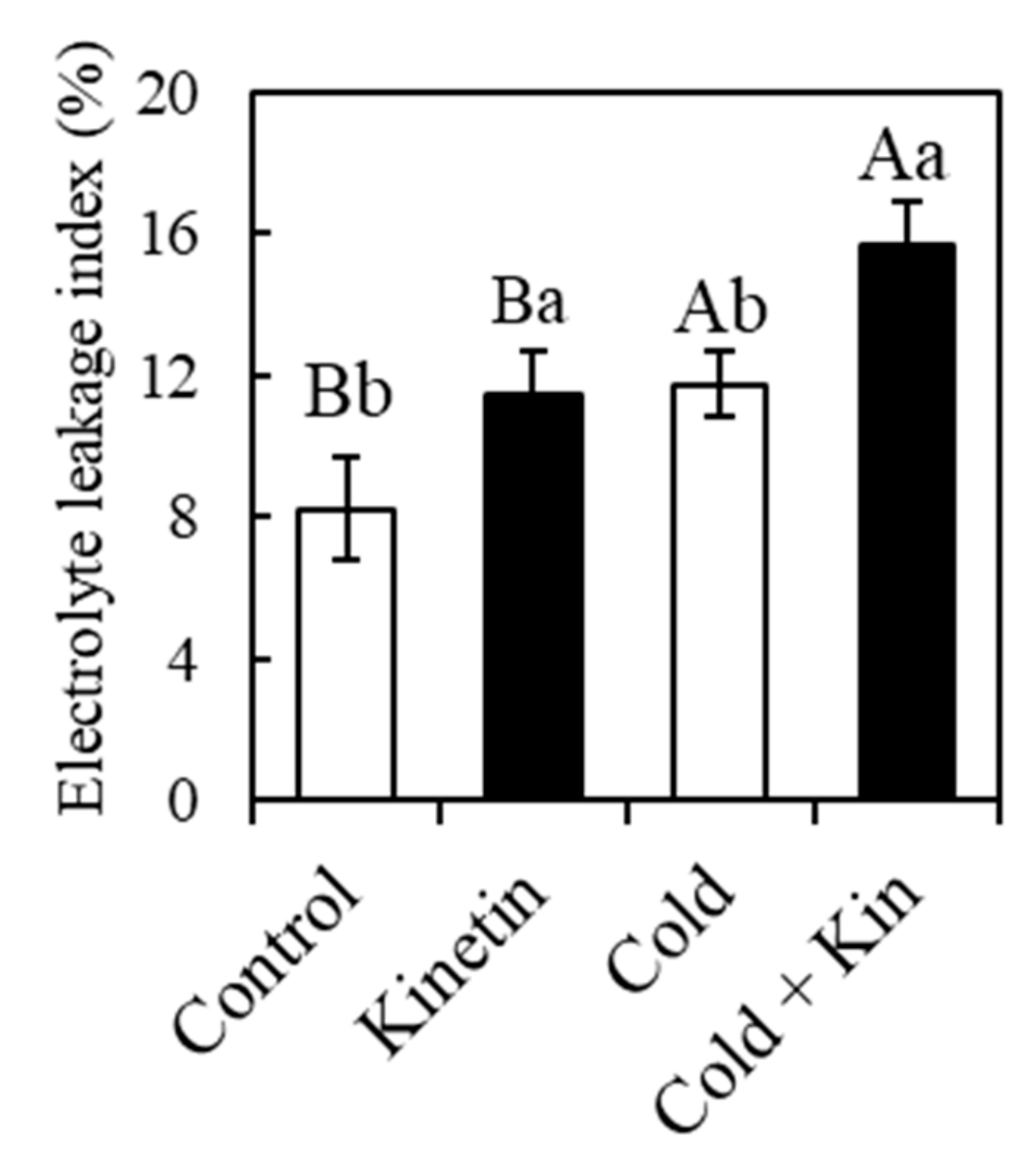
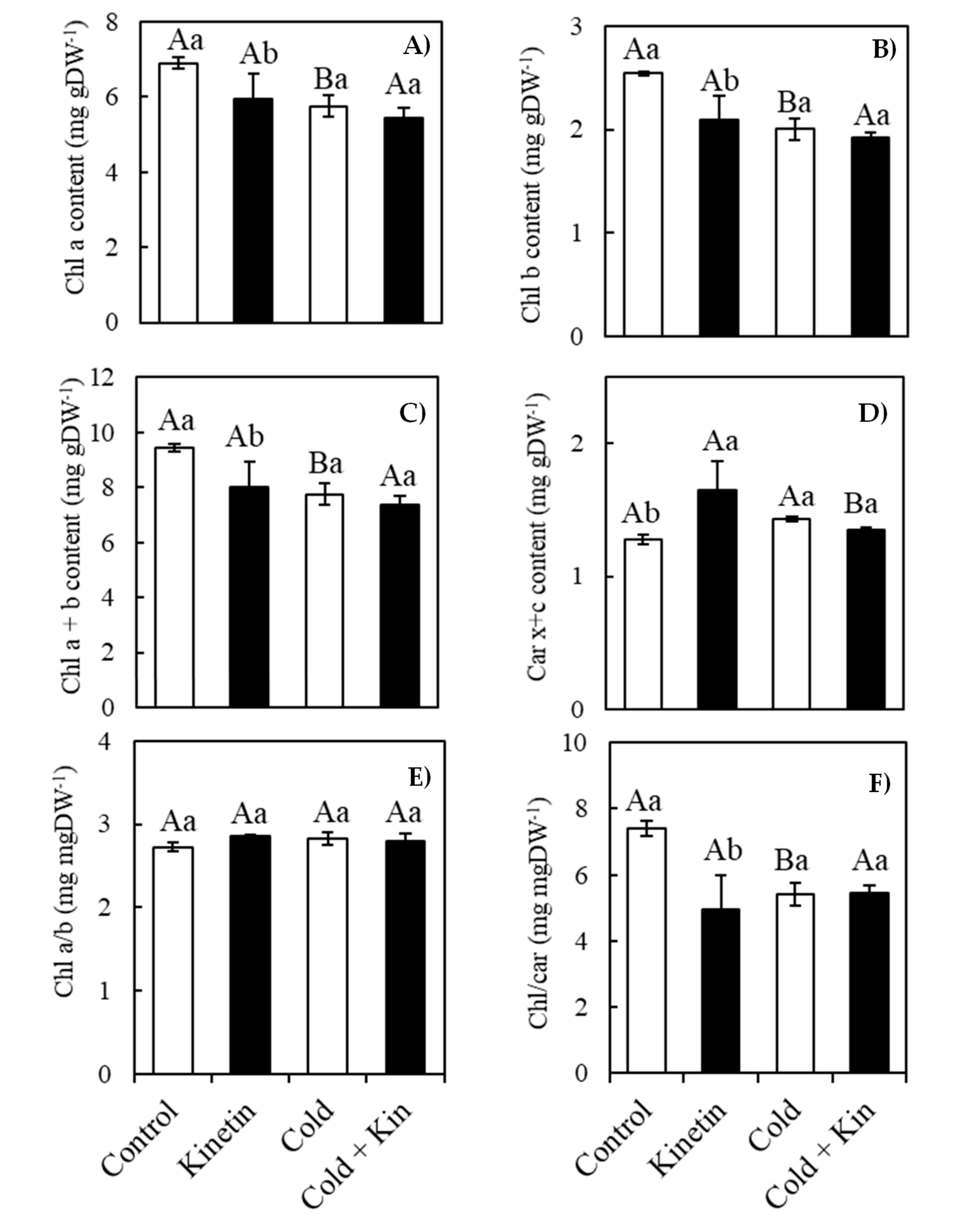
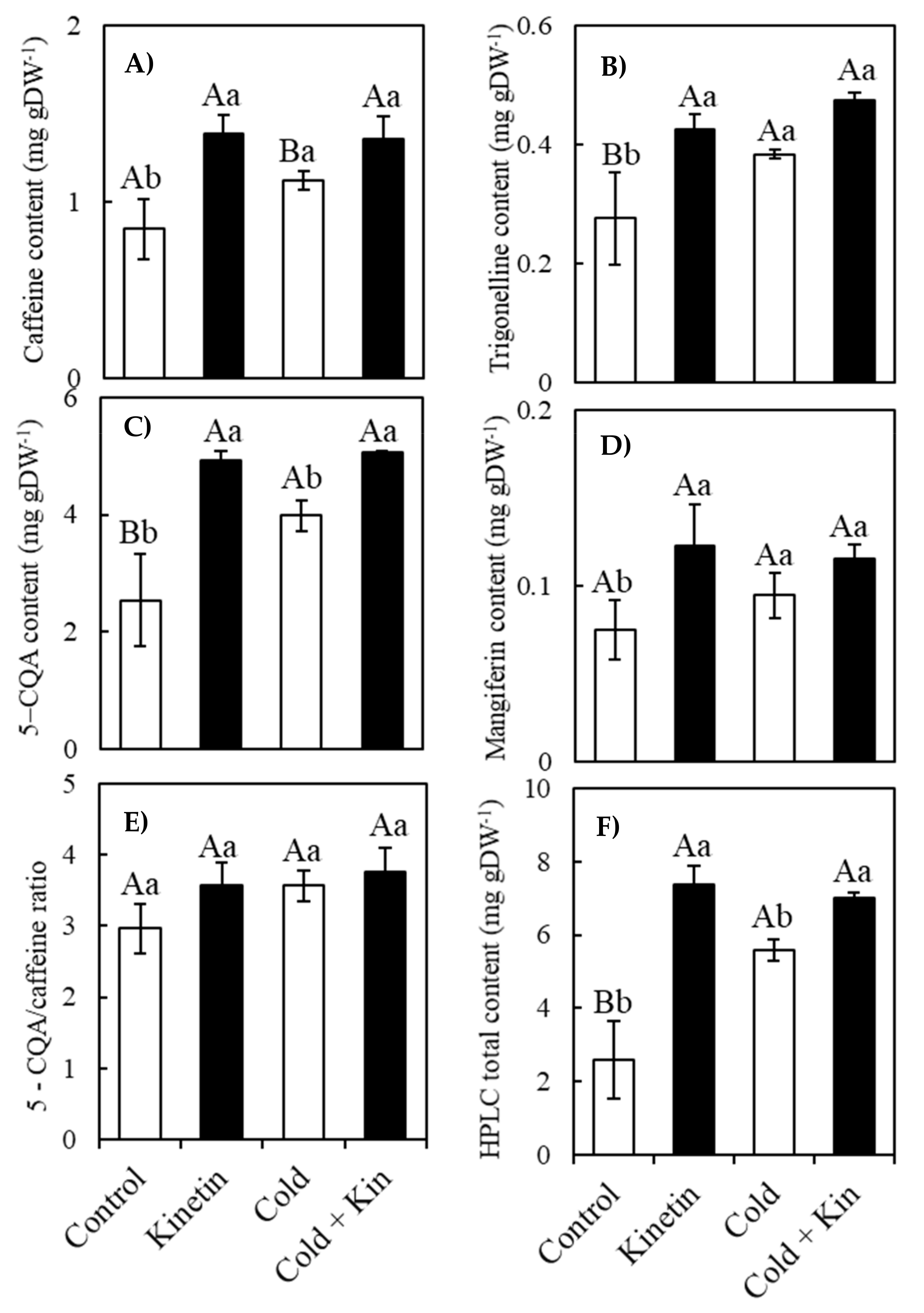
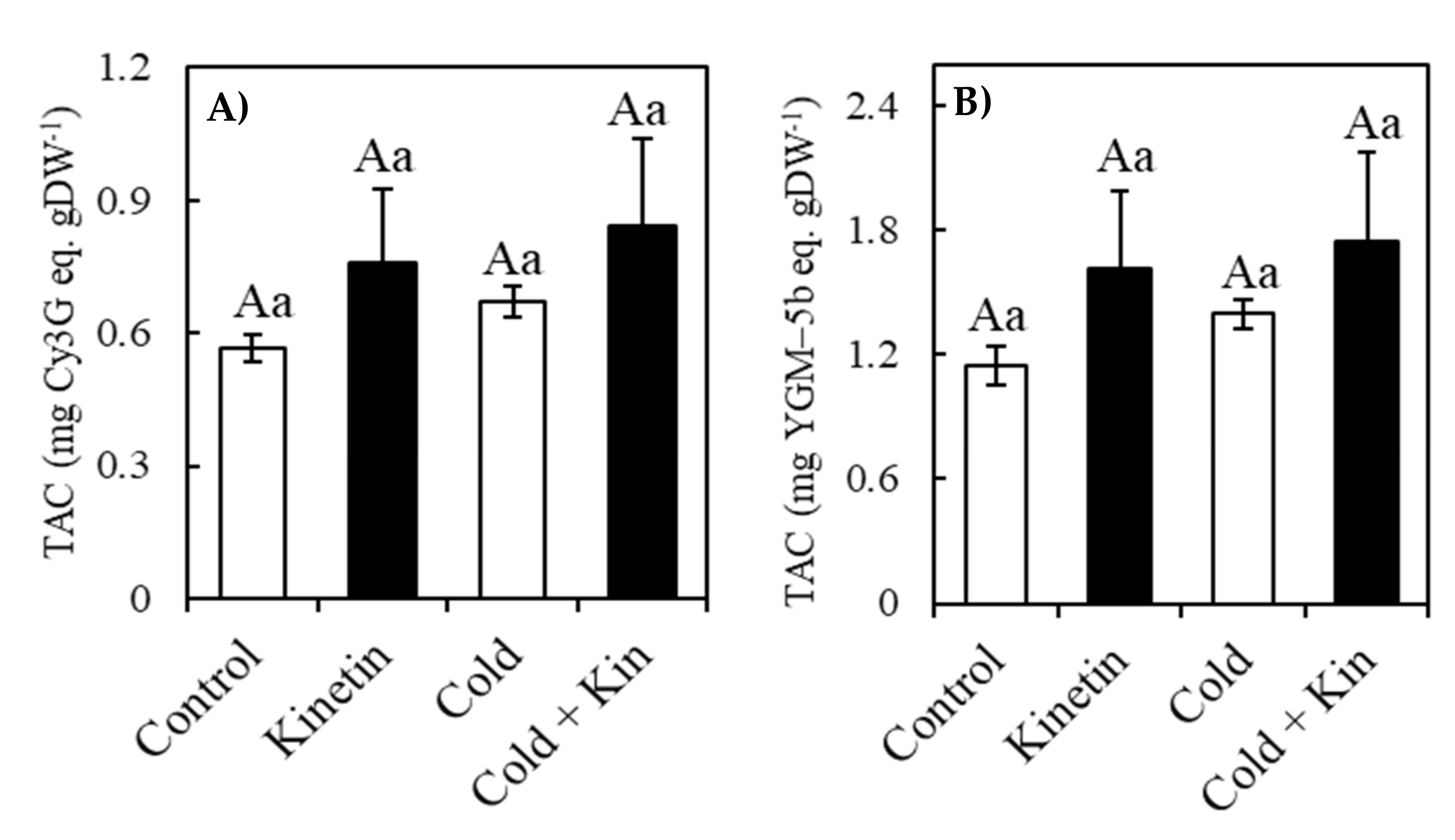
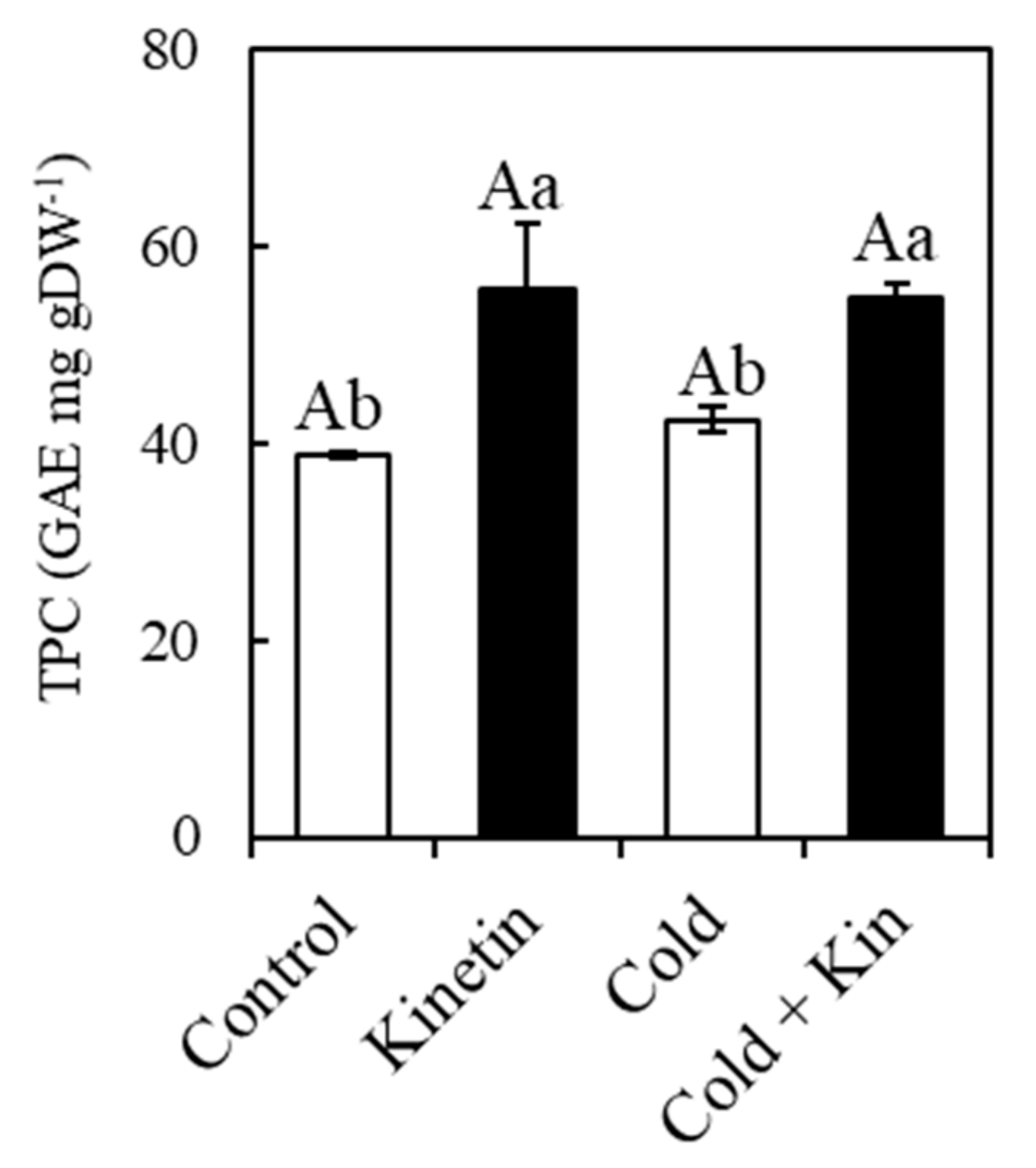
| Parameter | Optimum Conditions | Cold Stress Conditions | ||
|---|---|---|---|---|
| Control | Kinetin | Cold | Cold + Kinetin | |
| A (µmoL CO2 m−2 s−1) | 2.84 ± 1.61 Aa | 1.83 ± 0.11 Aa | 1.55 ± 0.55 Aa | 2.54 ± 0.17 Aa |
| gs (mmoL m−2 s−1) | 31.9 ± 16.1 Aa | 17.6 ± 3.2 Aa | 8.12 ± 4.7 Ba | 18.0 ± 1.8 Aa |
| A/gs (µmoL mmol−1) | 0.10 ± 0.04 Ba | 0.11 ± 0.02 Aa | 0.21 ± 0.05 Aa | 0.14 ± 0.02 Ab |
| A/E (µmoL mmol−1) | 4.13 ± 1.86 Ba | 3.99 ± 0.88 Aa | 10.4 ± 2.62 Aa | 7.03 ± 0.79 Ab |
| Trmmol (mmoL H2O m−2 s−1) | 0.75 ± 0.38 Aa | 0.47 ± 0.08 Aa | 0.17 ± 0.10 Bb | 0.36 ± 0.04 Aa |
| ci (µL L−1) | 333 ± 125 Aa | 215 ± 37.8 Aa | 81.2 ± 54.9 Ba | 161.9 ± 29.7 Aa |
| ci/ca | 0.83 ± 0.31 Aa | 0.54 ± 0.09 Aa | 0.05 ± 0.003 Bb | 0.41 ± 0.07 Aa |
| ci/gs | 7.91 ± 1.03 Ab | 12.23 ± 0.15 Aa | 7.54 ± 3.00 Aa | 8.95 ± 1.04 Ba |
| Parameter | Optimum Condition | Cold Stress Conditions | ||
|---|---|---|---|---|
| Control | Kinetin | Cold | Cold + Kinetin | |
| ΦPSII | 0.15 ± 0.03 Aa | 0.13 ± 0.02 Aa | 0.09 ± 0.02 Aa | 0.09 ± 0.01 Aa |
| ETR (µmoL m−2 s−1) | 31.8 ± 6.0 Aa | 28.7 ± 3.6 Aa | 19.4 ± 4.1 Ba | 20.0 ± 2.9 Aa |
| qP | 0.28 ± 0.04 Aa | 0.24 ± 0.05 Aa | 0.21 ± 0.02 Aa | 0.23 ± 0.04 Ba |
| qN | 2.08 ± 0.01 Aa | 2.30 ± 0.33 Aa | 1.72 ± 0.15 Aa | 1.69 ± 0.14 Ba |
| NPQ | 1.27 ± 0.45 Aa | 1.12 ± 0.50 Aa | 0.68 ± 0.48 Aa | 0.71 ± 0.41 Aa |
| qL | 0.50 ± 0.08 Aa | 0.47 ± 0.04 Aa | 0.33 ± 0.05 Ba | 0.35 ± 0.04 Ba |
| Parameter | Optimum Conditions | Cold Stress Conditions | ||
|---|---|---|---|---|
| Control | Kinetin | Cold | Cold + Kinetin | |
| Fv’/Fm’ | 0.52 ± 0.02 Aa | 0.56 ± 0.06 Aa | 0.42 ± 0.05 Ba | 0.40 ± 0.05 Ba |
| Fv/Fm | 0.75 ± 0.04 Aa | 0.75 ± 0.02 Aa | 0.57 ± 0.14 Aa | 0.58 ± 0.05 Aa |
| Fv’/Fo’ | 1.08 ± 0.10 Aa | 1.30 ± 0.33 Aa | 0.72 ± 0.15 Aa | 0.69 ± 0.14 Ba |
| Fv/Fo | 3.02 ± 0.71 Aa | 3.00 ± 0.25 Aa | 1.46 ± 0.75 Ba | 1.43 ± 0.31 Ba |
| Parameter | Optimum Condition | Cold Stress Conditions | ||
|---|---|---|---|---|
| Control | Kinetin | Cold | Cold + Kinetin | |
| DPPH IC50 µgDW mL−1 | 125.8 ± 21.5 Ba | 114.4 ± 12.7 Aa | 154.0 ± 8.5 Aa | 1102.8 ± 7.2 Ab |
| DPPH TEAC (µmoL Trolox gDW−1) | 211.3 ± 0.1 Ab | 317.9 ± 30.5 Aa | 190.2 ± 10.6 Ab | 270.1 ± 35. 2 Ba |
| ABTS TEAC (µmoL Trolox gDW−1) | 262.2 ± 3.0 Aa | 277.2 ± 19.4 Aa | 236.9 ± 23.3 Ab | 281.6 ± 7.15 Aa |
| FRAP TEAC (µmoL Trolox gDW−1) | 752.5 ± 73.8 Ab | 1138.6 ± 169.6 Aa | 542.1 ± 48.4 Bb | 938.7 ± 78.6 Ba |
© 2020 by the authors. Licensee MDPI, Basel, Switzerland. This article is an open access article distributed under the terms and conditions of the Creative Commons Attribution (CC BY) license (http://creativecommons.org/licenses/by/4.0/).
Share and Cite
Acidri, R.; Sawai, Y.; Sugimoto, Y.; Handa, T.; Sasagawa, D.; Masunaga, T.; Yamamoto, S.; Nishihara, E. Exogenous Kinetin Promotes the Nonenzymatic Antioxidant System and Photosynthetic Activity of Coffee (Coffea arabica L.) Plants Under Cold Stress Conditions. Plants 2020, 9, 281. https://doi.org/10.3390/plants9020281
Acidri R, Sawai Y, Sugimoto Y, Handa T, Sasagawa D, Masunaga T, Yamamoto S, Nishihara E. Exogenous Kinetin Promotes the Nonenzymatic Antioxidant System and Photosynthetic Activity of Coffee (Coffea arabica L.) Plants Under Cold Stress Conditions. Plants. 2020; 9(2):281. https://doi.org/10.3390/plants9020281
Chicago/Turabian StyleAcidri, Robert, Yumiko Sawai, Yuko Sugimoto, Takuo Handa, Daisuke Sasagawa, Tsugiyaki Masunaga, Sadahiro Yamamoto, and Eiji Nishihara. 2020. "Exogenous Kinetin Promotes the Nonenzymatic Antioxidant System and Photosynthetic Activity of Coffee (Coffea arabica L.) Plants Under Cold Stress Conditions" Plants 9, no. 2: 281. https://doi.org/10.3390/plants9020281
APA StyleAcidri, R., Sawai, Y., Sugimoto, Y., Handa, T., Sasagawa, D., Masunaga, T., Yamamoto, S., & Nishihara, E. (2020). Exogenous Kinetin Promotes the Nonenzymatic Antioxidant System and Photosynthetic Activity of Coffee (Coffea arabica L.) Plants Under Cold Stress Conditions. Plants, 9(2), 281. https://doi.org/10.3390/plants9020281





